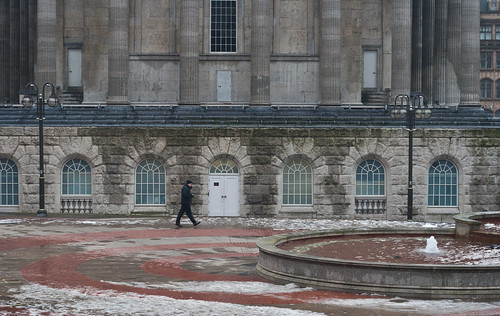Today was the inaugural five-hour lesson of Matt & Pete's Photo School in which 10 strangers met upstairs in Birmingham's Victoria pub to learn more about photography and how to improve our own efforts.
The framework of the day – after tea and coffee – involved an hour of learning a bit about the technical side of how a camera works, a bit about Henri Cartier-Bresson and a bit about the theory and style of street photography.
Then Matt and Pete set out three rules for our photowalk around Birmingham:
- use a fixed focal length on the lens (no zooming!)
- use the rule of thirds in some of the compositions
- frame your chosen scene, wait for someone to walk into it and then take the shot
On the walk, I found the rule of thirds pretty easy to apply. But having a fixed 50mm lens and trying to find a good frame was disconcerting.
The fixed lens also meant getting closer to strangers and taking the risk of being invasive, but mostly they seemed to be buried deep in their own worlds. The discomfort was more mine. This was not helped by a sticky shutter button – a known problem on some Canon DSLRs – which kept delaying the shot, leaving me with a lot of 'nearly but not quite' pictures.
I chose the one above as an example of that. I was playing with shutter priority and using a slow speed to create motion blur. Luckily, one of the subjects turned to face the camera as I pressed the shutter button, which created a nice focal point. Unfortunately the act of pressing the button shifted the camera slightly and all the static lines of the steps and Town Hall columns end up blurred rather than crisp.
I presented it as an interesting failure but was surprised that the photo got a fairly positive critique. Apart from the unintended camera shake, the overall effect is quite painterly, the feel was accidentally 'very Cartier-Bresson' and it led to some discussion about how boring 'perfect' photos can be in the digital world and how non-standard ones can jump out at you. I did take better photos but the critique at the end of the day opened up my thoughts about the emotional effects of a photo that isn't technically perfect.
I don't want to go into all the issues that I have with my own photographs but one of the main things I've realised is that apart from a couple of rules of composition and my own personal likes, I lack confidence in judging a photograph. I don't have a strong sense of when a photo is good or not. The end result of this is taking an endless series of photos rather than taking control of the creative decisions and shooting less.
The other thing I learnt about myself today is that I need to slow down. I tend to get frustrated at missing the shot but perhaps I need to see this type of photography more like going fishing: set up the equipment, throw the line out, sit back and see if you get a catch. If you don't, then just chill and start again. Enjoy it!
Or something.
It will be interesting to see what the others produced in the Photo School Flickr group.
The next session is in a month's time and will involve stepping away from the 'normal view' to investigate wide angles, landscapes and a photowalk around some of Brum's iconic buildings. Looking forward to the fancy learning, the practical stuff, meeting people and getting my head around 'me' as a photographer.
More info on how to bag a place is here.
Otherwise here are the other three photos I took today that I think have some merit:




V interesting. Invading people: If you use a tripod (plus cable release) you can be looking somewhere that's NOT your subject while you take the pic. Hassleblad and other cameras that you don't hold up to your eye are also fairly discreet. I have a couple of old 120 roll-film cameras which are also useful for this. (getting 120-format film processed is a bugger tho). Had discussion on FB with mate re: 1/3rds rule – it works sometimes but best not to be too slavish?? digital's easy enough to crop anyway. Also after FB discussion I thought keerist – at one time a lot of it was about happy accidents when pix came back front Boots the Chemist. Very good luck to Pete for this enterprise – sounds a) dead good b) fun.
Cheers Ray. I agree with the thirds rule, and Matt pointed out its overuse on the course. But I suppose there's value in knowing the rule for beginners. They also covered the golden spiral on the course, which was a new one on me.
PS. Keerist?
A while back (mid-2000s) I taught a photography theory module at Uni. Each year I used to enjoy revisiting Roland Barthes' short book Camera Lucida.
In it he uses the term 'Punctum' which he says is the "sting, speck, cut, little hole – and also the cast of the dice. A photograph’s punctum is that accident which pricks me (but also bruises me, is poignant to me)"
He argues that most photographs were too 'general', they had no Punctum that disrupted their technique. The top pic has punctum perhaps. I think maybe it's in the turned head of the woman in the white coat.
Dave – thanks for that. There's a definite element of the accidental in this shot – whether it's appealing enough for punctum levels, I can't say. PS. You don't have to tell me about Barthes' punctum – I based my entire 20,000 word pop music dissertation on it, asking if the same rules can be applied to formulaic mass produced pop music. I called it Prick Up Your Ears. 😉